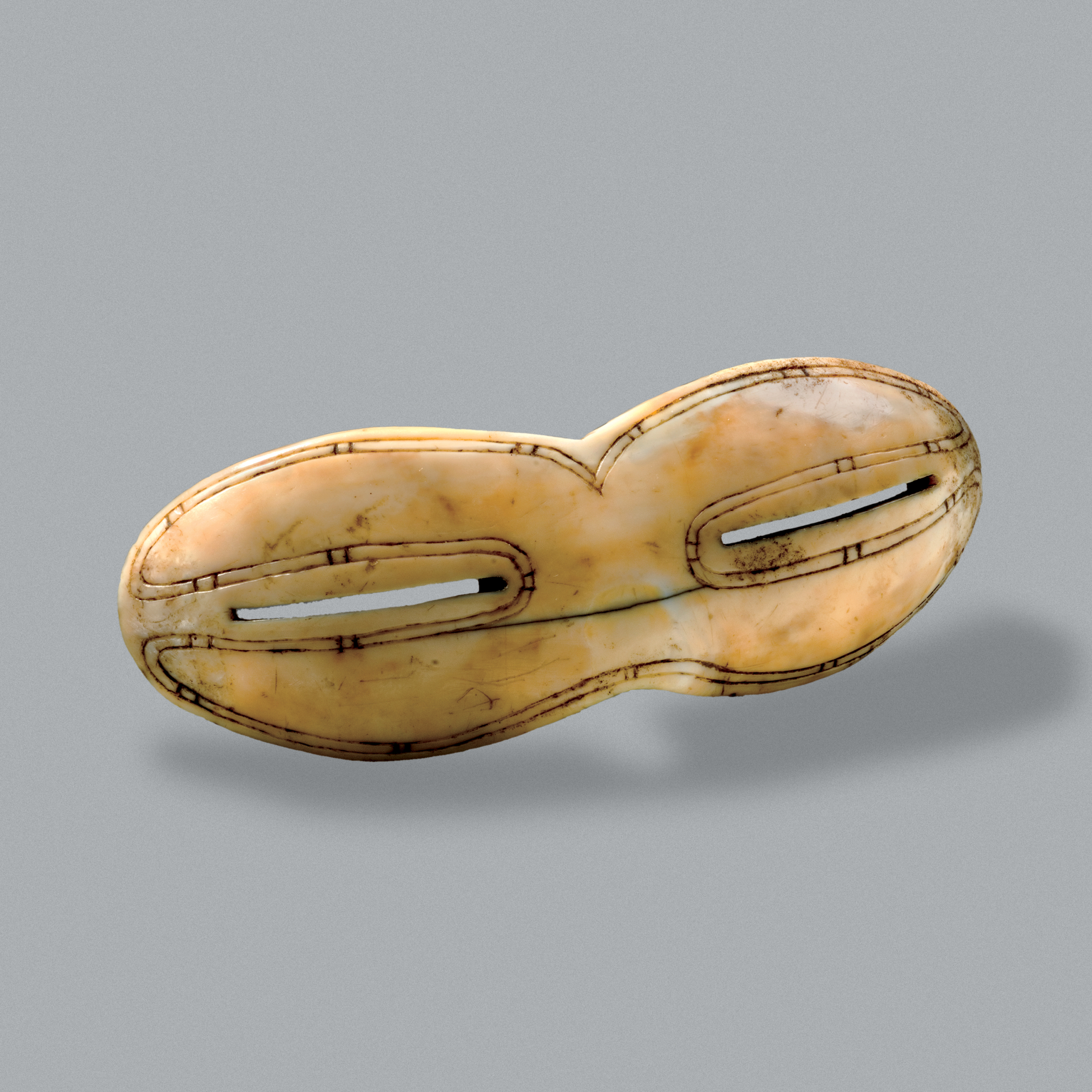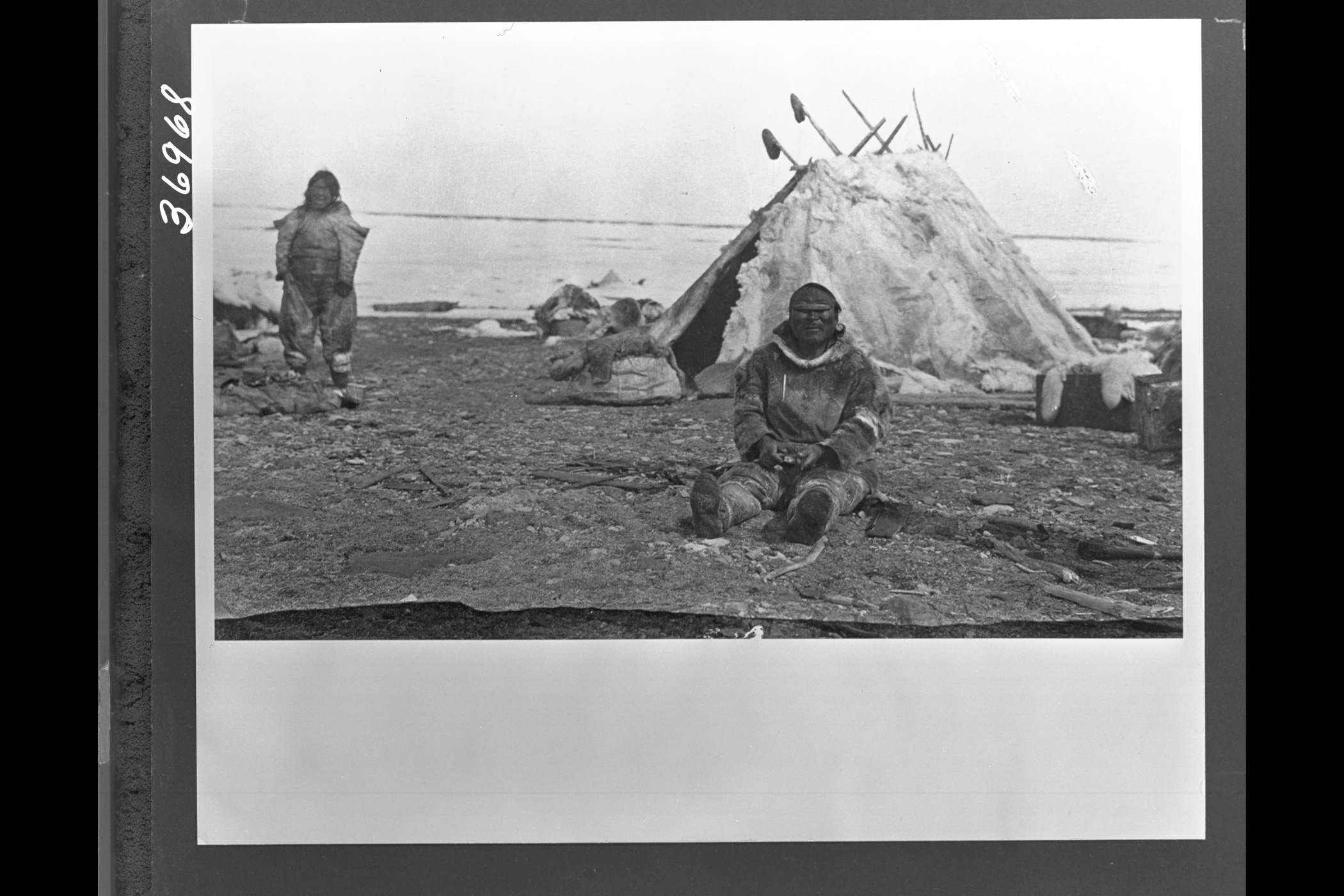Snow Goggles
Artifact
Image
Video
Audio
 Activities
Activities
LOOK
Look at this object. What do you think its purpose is? Verify your answer by reading the Historical Context below.
THINK
Watch the interview with Ross Kayotak, the artist who created snow goggles for the History Box. If you could ask him any questions, what would they be?
Details
 Materials
Materials - Walrus ivory
Historical Context
Choose one of the three levels below to match your needs.
- This is a pair of ivory snow goggles, designed to protect the wearer while hunting or travelling on spring ice. They were found in an early Inuit house on Baffin Island.
- Without snow goggles, people risk snow-blindness, a painful condition likened to a sunburn on the eyes.
- Generations of Inuit have developed and shared special skills that not only help them flourish in a harsh environment, but also contribute to a unique and vibrant culture.
Scroll through the media carousel above to see a photo of the goggles included in the History Box, an interview with Ross Kayotak — the artist who made the goggles, a photograph of a man wearing snow goggles, and a photograph of a walrus.
This is a pair of ivory snow goggles, designed to protect the wearer while hunting or travelling on spring ice. They were found in an early Inuit house on Baffin Island. Without snow goggles, people risk snow-blindness, a painful condition likened to a sunburn on the eyes.
Inuit (meaning “people” in the Inuktitut language) live in four circumpolar, or Arctic, countries: Russia, the United States (Alaska), Greenland and Canada.
Generations of Inuit have developed and shared special skills that not only help them flourish in a harsh environment, but also contribute to a unique and vibrant culture.
This pair of ivory snow goggles was designed to protect the wearer while hunting or travelling on spring ice. The goggles were found in an early Inuit house on Baffin Island.
Inuit (meaning “people” in the Inuktitut language) live in four northern circumpolar countries: Russia, the United States (Alaska), Greenland and Canada. In Canada, the Inuvialuit, Nunavut, Nunavik and Nunatsiavut regions make up Inuit Nunangat, the Inuit term for their homeland.
Generations of Inuit have developed and shared special skills that not only help them flourish in a harsh environment, but also contribute to a unique and vibrant culture.
Snow goggles, which can be made of antler, musk-ox horn, bone, wood or ivory, work like sunglasses to protect a person’s eyes from sunlight reflecting off ice and snow. Without snow goggles, people risk snow-blindness, a painful condition likened to a sunburn on the eyes.
The Canadian Museum of History has more than 100 pairs of Inuit snow goggles in its collection.
The snow goggles in this kit were made by Ross Kayotak, an Inuit artist who lives in Igoolik, Nunavut.
- This is a pair of ivory snow goggles, designed to protect the wearer while hunting or travelling on spring ice. They were found in an early Inuit house on Baffin Island.
- Without snow goggles, people risk snow-blindness, a painful condition likened to a sunburn on the eyes.
- Generations of Inuit have developed and shared special skills that not only help them flourish in a harsh environment, but also contribute to a unique and vibrant culture.
Scroll through the media carousel above to see a photo of the goggles included in the History Box, an interview with Ross Kayotak — the artist who made the goggles, a photograph of a man wearing snow goggles, and a photograph of a walrus.
This is a pair of ivory snow goggles, designed to protect the wearer while hunting or travelling on spring ice. They were found in an early Inuit house on Baffin Island. Without snow goggles, people risk snow-blindness, a painful condition likened to a sunburn on the eyes.
Inuit (meaning “people” in the Inuktitut language) live in four circumpolar, or Arctic, countries: Russia, the United States (Alaska), Greenland and Canada.
Generations of Inuit have developed and shared special skills that not only help them flourish in a harsh environment, but also contribute to a unique and vibrant culture.
This pair of ivory snow goggles was designed to protect the wearer while hunting or travelling on spring ice. The goggles were found in an early Inuit house on Baffin Island.
Inuit (meaning “people” in the Inuktitut language) live in four northern circumpolar countries: Russia, the United States (Alaska), Greenland and Canada. In Canada, the Inuvialuit, Nunavut, Nunavik and Nunatsiavut regions make up Inuit Nunangat, the Inuit term for their homeland.
Generations of Inuit have developed and shared special skills that not only help them flourish in a harsh environment, but also contribute to a unique and vibrant culture.
Snow goggles, which can be made of antler, musk-ox horn, bone, wood or ivory, work like sunglasses to protect a person’s eyes from sunlight reflecting off ice and snow. Without snow goggles, people risk snow-blindness, a painful condition likened to a sunburn on the eyes.
The Canadian Museum of History has more than 100 pairs of Inuit snow goggles in its collection.
The snow goggles in this kit were made by Ross Kayotak, an Inuit artist who lives in Igoolik, Nunavut.
Summary
- This is a pair of ivory snow goggles, designed to protect the wearer while hunting or travelling on spring ice. They were found in an early Inuit house on Baffin Island.
- Without snow goggles, people risk snow-blindness, a painful condition likened to a sunburn on the eyes.
- Generations of Inuit have developed and shared special skills that not only help them flourish in a harsh environment, but also contribute to a unique and vibrant culture.
Scroll through the media carousel above to see a photo of the goggles included in the History Box, an interview with Ross Kayotak — the artist who made the goggles, a photograph of a man wearing snow goggles, and a photograph of a walrus.
Essential
This is a pair of ivory snow goggles, designed to protect the wearer while hunting or travelling on spring ice. They were found in an early Inuit house on Baffin Island. Without snow goggles, people risk snow-blindness, a painful condition likened to a sunburn on the eyes.
Inuit (meaning “people” in the Inuktitut language) live in four circumpolar, or Arctic, countries: Russia, the United States (Alaska), Greenland and Canada.
Generations of Inuit have developed and shared special skills that not only help them flourish in a harsh environment, but also contribute to a unique and vibrant culture.
In-Depth
This pair of ivory snow goggles was designed to protect the wearer while hunting or travelling on spring ice. The goggles were found in an early Inuit house on Baffin Island.
Inuit (meaning “people” in the Inuktitut language) live in four northern circumpolar countries: Russia, the United States (Alaska), Greenland and Canada. In Canada, the Inuvialuit, Nunavut, Nunavik and Nunatsiavut regions make up Inuit Nunangat, the Inuit term for their homeland.
Generations of Inuit have developed and shared special skills that not only help them flourish in a harsh environment, but also contribute to a unique and vibrant culture.
Snow goggles, which can be made of antler, musk-ox horn, bone, wood or ivory, work like sunglasses to protect a person’s eyes from sunlight reflecting off ice and snow. Without snow goggles, people risk snow-blindness, a painful condition likened to a sunburn on the eyes.
The Canadian Museum of History has more than 100 pairs of Inuit snow goggles in its collection.
The snow goggles in this kit were made by Ross Kayotak, an Inuit artist who lives in Igoolik, Nunavut.



